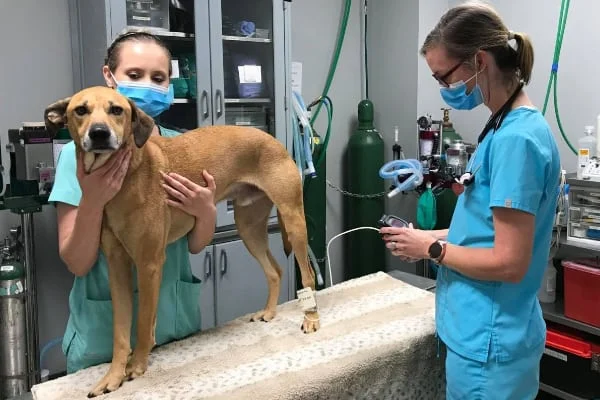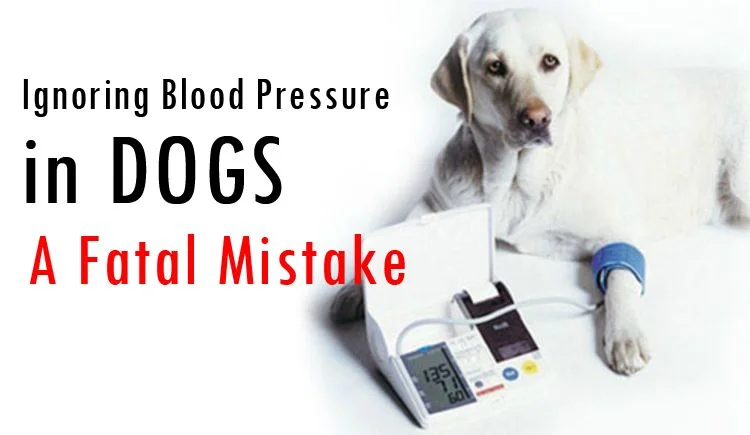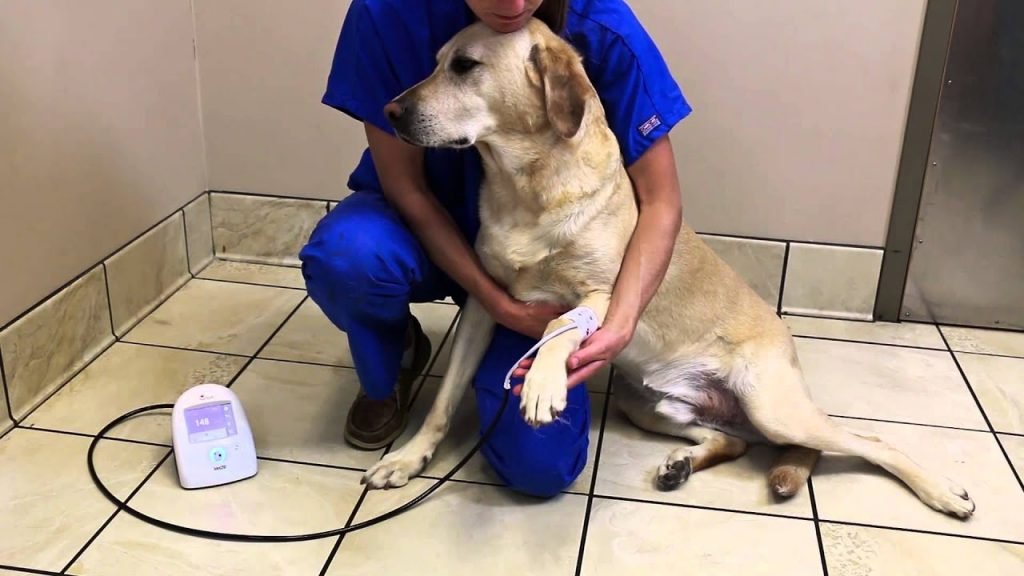As a German Shepherd owner, I’ve learned that High Blood Pressure in dogs is a serious condition that requires immediate attention. When my dog Max’s systolic blood pressure readings consistently showed above 160 mmHg during routine check-ups, our vet explained that normal canine blood pressure should be below 150 mmHg.
High blood pressure in dogs can be subtle yet dangerous. Through my experience with Max, I discovered these critical blood pressure ranges:
- Normal: Below 150 mmHg systolic
- Borderline: 150-159 mmHg systolic
- Hypertensive: 160-180 mmHg systolic
- Severe: Above 180 mmHg systolic
Early recognition saved Max from potential complications. Dogs can’t tell us when they’re feeling unwell, making it crucial for us as pet parents to watch for warning signs. Untreated hypertension can damage vital organs, including the eyes, kidneys, heart, and brain.
I’m sharing our journey to help other dog owners understand the importance of regular blood pressure monitoring and early intervention. Quick action can prevent life-threatening complications and ensure our furry companions live longer, healthier lives.
Table of Contents
Understanding Hypertension in Dogs
My German Shepherd’s diagnosis opened my eyes to the complexity of canine hypertension. Through consultations with my vet, I learned there are two distinct types of high blood pressure in dogs:

1. Primary Hypertension
- A rare condition where blood pressure rises without an underlying cause
- Accounts for less than 5% of hypertension cases in dogs
- Requires careful monitoring and specific medication protocols
2. Secondary Hypertension
- The most common form, linked to underlying health conditions
- Key causes I discussed with my vet include:
- Chronic kidney disease
- Cushing’s disease
- Diabetes mellitus
- Adrenal tumors
Age plays a significant role in hypertension risk. Dogs over 10 years old face higher chances of developing high blood pressure. My vet explained certain breeds show increased susceptibility:
- Sight hounds
- Poodles
- Dachshunds
- Cocker Spaniels
During our regular check-ups, my vet emphasized how breeds prone to kidney disease or endocrine disorders need extra attention. These conditions can trigger secondary hypertension, making early detection crucial for effective management.
Also Read: 5 Best Dog Crates for Separation Anxiety (Updated 2025)
The relationship between age and hypertension became clear when my vet showed me statistics: approximately 80% of dogs with chronic kidney disease develop high blood pressure. This knowledge helped me understand why regular blood pressure monitoring became essential as my dog aged.
Causes of High Blood Pressure in Dogs
When my German Shepherd Max developed hypertension, my vet explained several underlying conditions that can trigger this condition. Let me share what I learned about these causes:
1. Chronic Kidney Disease
The kidneys play a crucial role in blood pressure regulation. When they’re damaged, they can’t filter blood properly, leading to fluid retention and increased blood volume. This puts extra pressure on blood vessel walls, raising blood pressure significantly.
2. Cushing’s Disease (Hyperadrenocorticism)
This endocrine disorder causes excessive cortisol production, affecting how the body manages blood pressure. The increased cortisol levels cause blood vessels to become more sensitive to substances that constrict them, resulting in higher blood pressure readings.
3. Diabetes Mellitus
High blood sugar levels damage blood vessels over time, making them less elastic and more resistant to blood flow. This resistance forces the heart to pump harder, raising blood pressure.
4. Adrenal Tumors (Pheochromocytoma)
These rare tumors release excess hormones called catecholamines, causing sudden spikes in blood pressure. I’ve seen this create intense anxiety in affected dogs.
5. Other Contributing Factors

- Polycythemia: A condition where the body produces too many red blood cells, thickening the blood
- Central nervous system diseases: These can disrupt normal blood pressure regulation
- Obesity: Extra weight puts additional strain on the cardiovascular system
Recognizing Symptoms and Signs of Hypertension in Dogs
My German Shepherd, Max, showed no obvious signs of hypertension during his early stages – a common scenario I’ve learned many dog owners face. The subtle nature of this condition makes it particularly challenging to detect without regular veterinary check-ups.
Key Visual Symptoms
- Sudden blindness or vision changes
- Red, bloodshot eyes
- Dilated pupils that don’t respond to light
- Detached retinas (visible as a grayish film over the eyes)
Behavioral and Neurological Signs
- Unexplained disorientation
- Loss of balance or coordination
- Head tilting
- Seizures (which Max experienced once, prompting our emergency vet visit)
Physical Manifestations
- Recurring nosebleeds
- Irregular heart rhythms
- Audible heart murmurs (detected during routine examinations)
Urinary Changes
- Increased thirst
- Frequent urination
- Blood in urine
- Dark or cloudy urine
I noticed Max drinking more water than usual and making frequent trips to the backyard. These subtle changes, combined with his occasional disorientation, prompted me to seek veterinary care. Through my experience, I learned that catching these signs early can prevent severe complications like permanent blindness or kidney damage.
During Max’s initial symptoms, I maintained a daily log of his behavior changes, which proved invaluable for our veterinarian’s diagnosis. This systematic observation helped identify patterns in his symptoms and their progression.
Immediate First Aid Steps Before Consulting a Vet
When I noticed my German Shepherd showing signs of possible hypertension, I immediately implemented these crucial first aid steps before rushing to my vet:
1. Create a Calm Environment
- Dim the lights in the room
- Keep noise levels minimal
- Remove other pets from the area
- Speak in soft, soothing tones
- Place their favorite bed or blanket nearby
2. Restrict Movement
- Cancel planned walks or exercise
- Keep them in a quiet room
- Prevent jumping or running
- Allow gentle, slow movement only
3. Close Monitoring
- Watch for:
- Sudden collapse
- Head tilting
- Loss of balance
- Seizure activity
- Disorientation
- Document symptoms and timing
- Take photos/videos of concerning behaviors
I learned from my vet that these steps help prevent dangerous blood pressure spikes while awaiting professional care. My quick actions in keeping Max calm and monitoring his condition helped avoid potential complications during our drive to the emergency clinic.
Remember: These first aid measures don’t replace veterinary care – they’re temporary steps to stabilize your dog until professional help is available.
Diagnosing Hypertension in Dogs
When I took Max to the vet for his hypertension diagnosis, the process was thorough and systematic. The veterinary team used two primary methods to measure his blood pressure:
1. Doppler Method
- A small ultrasound probe detected blood flow in Max’s arteries
- The process required minimal fur shaving on his paw
- Readings were clear and precise, showing systolic pressure
2. Oscillometric Method
- An automated cuff measured both systolic and diastolic pressure
- Multiple readings were taken at 2-minute intervals
- The team averaged 5-7 measurements for accuracy
My vet explained that a single high reading wasn’t enough for diagnosis. Max needed several visits for consistent measurements, as stress can temporarily elevate blood pressure.
The diagnostic process included:
- Echocardiogram – revealed any heart enlargement or structural changes
- Blood Tests – checked kidney function, electrolytes, and hormone levels
- Urine Analysis – measured protein-to-creatinine ratio (UPC)
- Blood Chemistry Panel – identified underlying conditions like diabetes or Cushing’s disease
During Max’s examination, the vet team maintained a quiet environment and allowed him to acclimate to the room before taking measurements. This approach helped minimize the “white coat effect” – temporary blood pressure elevation due to veterinary visit stress.
The comprehensive testing helped identify both Max’s elevated blood pressure and its underlying cause, enabling us to start appropriate treatment promptly.
Potential Complications from Untreated Hypertension

My German Shepherd Max developed hypertension due to kidney disease, and I learned firsthand how devastating untreated high blood pressure can be. Through my experience and consultations with our vet, I discovered several serious complications that can arise if hypertension goes unchecked.
Eye Damage
- Sudden retinal detachment can occur within hours
- Blood vessels in the eyes can burst, causing permanent blindness
- I noticed Max squinting and bumping into furniture before we got his blood pressure under control
Kidney Complications
- Existing kidney disease worsens rapidly
- Protein-losing nephropathy develops as damaged kidneys leak proteins
- Increased thirst and urination signal progressive renal damage
Heart Issues
- Left ventricular hypertrophy – heart muscle thickens from working too hard
- Heart murmurs develop as blood flow patterns change
- Risk of congestive heart failure increases significantly
Neurological Impact
- Seizures can occur without warning
- Brain damage from reduced oxygen flow
- Strokes may happen when blood vessels rupture
- Changes in behavior or mental status
The damage from untreated hypertension builds silently but quickly. When Max started showing subtle signs, our quick action helped prevent many of these complications. Blood pressure monitoring became a regular part of our vet visits, allowing us to adjust his treatment as needed. We also learned about the importance of managing hypertension in dogs, which provided us with valuable insights into preventing these severe health issues.
Treatment Options for Hypertension in Dogs

When my German Shepherd was diagnosed with hypertension, my vet explained that successful treatment requires a two-pronged approach: managing blood pressure and addressing underlying conditions. Here’s what I learned about the treatment options:
Primary Medications:
- ACE Inhibitors (enalapril, benazepril): These medications dilate blood vessels. My dog started with a low dose, adjusted based on blood pressure readings.
- Calcium Channel Blockers (amlodipine): Works by relaxing arterial walls. We added this when ACE inhibitors alone weren’t enough.
Emergency Situations:
- Immediate hospitalization for blood pressures exceeding 200 mmHg
- Injectable medications like hydralazine for rapid pressure reduction
- Constant monitoring until stabilization
Managing Underlying Conditions:
- Specific medications for kidney disease, Cushing’s, or diabetes
- Regular blood work to track disease progression
- Adjusting medications based on response
Lifestyle Changes:
- Reduced physical activity during initial treatment phase
- Stress reduction through quiet environments
- Weight management if needed
My vet emphasized that medication dosages often need adjustment during the first few weeks. We scheduled weekly check-ups initially to monitor my dog’s response and fine-tune the treatment plan. The combination of medications and lifestyle changes helped bring his blood pressure under control within a month.
For a more comprehensive understanding of management of systemic hypertension in dogs, I recommend consulting with your veterinarian as they can provide more tailored advice based on your pet’s specific condition.
Long-Term Management and Monitoring
My German Shepherd Max requires consistent monitoring to manage his hypertension effectively. During our regular vet visits, I’ve learned the critical importance of maintaining a detailed health journal to track his progress.
Blood Pressure Monitoring Schedule:
- Weekly measurements during initial treatment phase
- Monthly check-ups once stabilized
- Immediate checks if new symptoms appear
I schedule Max’s blood pressure readings for the same time of day, typically when he’s most relaxed. This helps ensure accurate, consistent measurements and allows our vet to make informed decisions about his treatment plan.
The medication dosages need regular adjustment based on Max’s response. When his blood pressure started dropping too low, our vet reduced his amlodipine dose. This personalized approach has helped maintain his blood pressure within the target range of 140-160 mmHg systolic.
Managing Underlying Conditions:
- Regular kidney function tests every 3-6 months
- Blood glucose monitoring for diabetes management
- Thyroid hormone level checks
- Cushing’s disease monitoring through ACTH stimulation tests
I’ve created a home routine that includes:
- Measuring water intake
- Monitoring urine output
- Recording any changes in appetite
- Noting energy levels and behavior changes
These observations help our vet make informed decisions about Max’s treatment plan and catch any potential complications early. The comprehensive monitoring approach has significantly improved his quality of life and helped prevent serious complications.
Conclusion
As a German Shepherd owner who’s dealt with hypertension in my dog, I can’t stress enough how crucial immediate action is when you notice any warning signs. My experience taught me that waiting or hoping symptoms will resolve on their own can lead to devastating consequences.
Key takeaways from my journey:
- Blood pressure issues can strike any dog, regardless of age or breed
- Early intervention dramatically improves treatment outcomes
- Regular vet check-ups are your best defense against complications
- A proper medication schedule, combined with lifestyle management, helps maintain stable blood pressure
I’ve learned that managing canine hypertension is a partnership between you and your vet. The effort you put into monitoring symptoms, maintaining medication schedules, and attending follow-up appointments directly impacts your dog’s quality of life.
Remember – your quick action in seeking veterinary care could save your dog’s eyesight, protect their kidneys, and prevent life-threatening complications. Your dog relies on you to be their health advocate.

